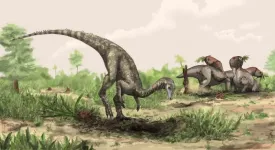(Press-News.org) The remains of the earliest dinosaurs may lie undiscovered in the Amazon and other equatorial regions of South America and Africa, suggests a new study led by UCL (University College London) researchers.
Currently, the oldest known dinosaur fossils date back about 230 million years and were unearthed further south in places including Brazil, Argentina and Zimbabwe. But the differences between these fossils suggest dinosaurs had already been evolving for some time, pointing to an origin millions of years earlier.
The new study, published in the journal Current Biology, accounted for gaps in the fossil record and concluded that the earliest dinosaurs likely emerged in a hot equatorial region in what was then the supercontinent Gondwana – an area of land that encompasses the Amazon, Congo basin, and Sahara Desert today.
Lead author and PhD student Joel Heath (UCL Earth Sciences and the Natural History Museum, London) said: “Dinosaurs are well studied but we still don’t really know where they came from. The fossil record has such large gaps that it can’t be taken at face value.
“Our modelling suggests that the earliest dinosaurs might have originated in western, low-latitude Gondwana. This is a hotter and drier environment than previously thought, made up of desert- and savannah-like areas.
“So far, no dinosaur fossils have been found in the regions of Africa and South America that once formed this part of Gondwana. However, this might be because researchers haven’t stumbled across the right rocks yet, due to a mix of inaccessibility and a relative lack of research efforts in these areas.”
The modelling study drew on fossils and evolutionary trees of dinosaurs and their close reptile relatives, as well as the geography of the period. It accounted for gaps in the fossil record by treating areas of the globe where no fossils had been found as missing information rather than areas where no fossils exist.
Initially, early dinosaurs were vastly outnumbered by their reptile cousins.
These included the ancestors of crocodiles, the pseudosuchians (an abundant group including enormous species up to 10 metres long), and pterosaurs, the first animals to evolve powered flight (flying by flapping wings rather than gliding), who grew as big as fighter jets.
By contrast, the earliest dinosaurs were much smaller than their descendants – more the size of a chicken or dog than a Diplodocus. They walked on two legs (were bipedal) and most are thought to have been omnivores.
Dinosaurs became dominant after volcanic eruptions wiped out many of their reptile relatives 201 million years ago.
The new modelling results suggested that dinosaurs as well as other reptiles may have originated in low-latitude Gondwana, before radiating outwards, spreading to southern Gondwana and to Laurasia, the adjacent northern supercontinent that later split into Europe, Asia and North America.
Support for this origin comes from the fact it is a midpoint between where the earliest dinosaurs have been found in southern Gondwana and where the fossils of many of their close relatives have been discovered to the north in Laurasia.
As there is uncertainty about how the most ancient dinosaurs were related to one another and to their close relatives, the researchers ran their model on three proposed evolutionary trees.
They found strongest support for a low-latitude Gondwanan origin of the dinosaurs in the model that counted silesaurids, traditionally regarded as cousins of dinosaurs but not dinosaurs themselves, as ancestors of ornithischian dinosaurs.
Ornithischians, one of the three main dinosaur groups that later included plant eaters Stegosaurus and Triceratops, are mysteriously absent from the fossil record of these early years of the dinosaur era. If silesaurids are the ancestors of ornithischians, this helps to fill in this gap in the evolutionary tree.
Senior author Professor Philip Mannion (UCL Earth Sciences) said: “Our results suggest early dinosaurs may have been well adapted to hot and arid environments. Out of the three main dinosaur groups, one group, sauropods, which includes the Brontosaurus and the Diplodocus, seemed to retain their preference for a warm climate, keeping to Earth’s lower latitudes.
“Evidence suggests the other two groups, theropods and ornithischians, may have developed the ability to generate their own body heat some millions of years later in the Jurassic period, allowing them to thrive in colder regions, including the poles.”
The earliest known dinosaurs include Eoraptor, Herrerasaurus, Coelophysis, and Eodromaeus.
END
New twist in mystery of dinosaurs' origin
2025-01-23
ELSE PRESS RELEASES FROM THIS DATE:
Baseline fasting glucose level, age, sex, and BMI and the development of diabetes in US adults
2025-01-23
About The Study: The results of this retrospective cohort study of 44,000 individuals suggest that fasting plasma glucose level, age, body mass index (BMI), and male sex were all associated with development of diabetes, with significant interaction between these variables. These data contribute to understanding the clinical course of diabetes and highlight the substantial individual variation in diabetes risk according to commonly measured clinical variables. The findings facilitate lifestyle and pharmacologic interventions to treat those at highest risk of diabetes to reduce future morbidity and mortality. Further work is needed to validate this risk ...
Food insecurity in pregnancy, receipt of food assistance, and perinatal complications
2025-01-23
About The Study: In this cohort study, food insecurity in pregnancy was associated with a higher risk of perinatal complications, and these associations were overall attenuated to the null among individuals who received food assistance in pregnancy. These findings support clinical guidelines of screening for food insecurity in pregnancy and provide evidence to expand food assistance programs that may help improve maternal and neonatal outcomes.
Corresponding Authors: To contact the corresponding authors, email Rana F. Chehab, PhD (Rana.Chehab@kp.org) and Yeyi ...
Exposure to secondhand cannabis smoke among children
2025-01-23
About The Study: In this cross-sectional study, in-home cannabis smoking was associated with significantly increased odds of child exposure to cannabis smoke, as assessed by urinary cannabinoid biomarkers. As young children spend most of their time at home, reducing in-home cannabis smoking could substantially reduce their exposure to the toxic and carcinogenic chemicals found in cannabis smoke.
Corresponding Authors: To contact the corresponding authors, email Osika Tripathi, PhD (otripath@health.ucsd.edu) and ...
New study reveals how a ‘non-industrialized’ style diet can reduce risk of chronic disease
2025-01-23
Researchers have found that a newly developed diet inspired by the eating habits of non-industrialised societies can significantly reduce the risk of a number of chronic diseases – and are to share recipes with the public.
Industrialised diets—high in processed foods and low in fiber— have contributed to a substantial rise in chronic diseases like obesity, diabetes, and heart disease, in affluent countries such as Ireland.
A paper published today in the prestigious scientific journal Cell shows that a newly developed diet that mimics eating habits in non-industrialissed ...
Plant’s name-giving feature found to be new offspring-ensuring method
2025-01-23
130 years after a fungus-eating plant received its name, a Kobe University researcher has uncovered the purpose of the structure that inspired its name — revealing a novel mechanism by which plants ensure reproduction.
MAKINO Tomitaro, a towering figure in Japanese botany, named around 1,000 species and discovered about 600 new plants between 1887 and 1957. Among his notable discoveries was the diminutive orchid Stigmatodactylus sikokianus, first identified in 1889. After Makino’s discovery, the plant was named for the unique, tiny finger-like appendage (the “dactylus” part) on its stigma, the flower’s ...
Predicting how childhood kidney cancers develop
2025-01-23
Genetically tailored treatment plans for children with a type of kidney cancer could help provide the most effective care while minimising side effects as much as possible.
Researchers at the Wellcome Sanger Institute, Cambridge University Hospitals NHS Foundation Trust, Great Ormond Street Hospital, the University of Würzburg, and their collaborators, have mapped the genetic differences across children with a type of childhood kidney cancer called Wilms tumour.
In about 30 per cent of children with Wilms tumour, there is an inherited genetic change that increases the risk of developing this cancer. This study, published today (23 January) in Cancer Discovery, ...
New optical memory unit poised to improve processing speed and efficiency
2025-01-23
WASHINGTON — Researchers have developed a new type of optical memory called a programmable photonic latch that is fast and scalable. This fundamental memory unit enables temporary data storage in optical processing systems, offering a high-speed solution for volatile memory using silicon photonics.
The new integrated photonic latch is modeled after a set-reset latch, a basic memory device used in electronic devices to store a single bit by switching between set (1) and reset (0) states based on inputs.
“While optical communications and computing have seen significant progress over the past decades, data storage has been predominantly implemented using electronic memory,” ...
World Leprosy Day: Tailored guidelines and reduced stigma needed to tackle leprosy, Irish case study reveals
2025-01-23
A case report published in Eurosurveillance on an adult with an imported case of leprosy in Ireland shows that there are notable challenges in tackling the disease in settings where it is rare. The affected individual was one of five individuals with leprosy reported in Ireland in the past decade. The authors report challenges faced in the public health response due to a delayed recognition of the symptoms by healthcare providers, a lack of specific Irish and European guidelines, and contact tracing in a congregate setting.
Ahead of World Leprosy Day, this case study highlights ...
FAU secures $21M Promise Neighborhoods grant for Broward UP underserved communities
2025-01-23
Despite South Florida’s reputation as paradise, the reality for many is stark. In the 2023-24 school year, Broward County reported more than 6,027 homeless children. The community also faces challenges like chronic absenteeism, mental health issues, poor nutrition, and limited access to quality early learning programs. These factors perpetuate a cycle of poverty and low educational attainment, hindering social mobility and the path to stronger communities.
To help address these issues, Florida Atlantic University has been selected as the recipient of a $21 million multi-year grant from the United States Department of Education Promise Neighborhoods ...
Korea-US leading research institutes accelerate collaboration for energy technology innovation
2025-01-23
The Korea Institute of Energy Research (KIER) signed a Memorandum of Understanding (MOU) with the U.S. Department of Energy’s (DOE’s) National Renewable Energy Laboratory (NREL) on January 9th to collaborate on key carbon-neutral technologies such as solar energy, hydrogen, and energy storage. The MOU was signed virtually via electronic signatures, with KIER President Chang-Keun Yi and NREL Director Dr. Martin Keller serving as the official signatories.
* NREL is a DOE national laboratory focused on the research and development of renewable energy and energy efficiency technologies, energy system integration, and sustainable transportation. NREL ...






